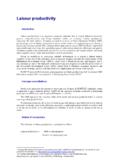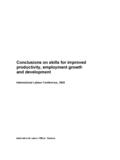Transcription of PRODUCTIVITY AND PERFORMANCE MANAGEMENT …
1 International Journal of PERFORMANCE Measurement, 2011, Vol. 1, 39-58. PRODUCTIVITY and PERFORMANCE MANAGEMENT Managerial Practices in the Construction Industry Aki Pekuri1. Harri Haapasalo2. Maila Herrala3. Abstract The purpose of this paper is to clarify the meanings of different terms related to PRODUCTIVITY and to analyze the state of PRODUCTIVITY in the Finnish construction industry at the macro level. This study reviews literature related to PRODUCTIVITY and PERFORMANCE MANAGEMENT ; its aim is to form an understanding of prevailing habits and shortcomings.
2 Based on a conducted macro level analysis, the research results show that the rate of PRODUCTIVITY development in the Finnish construction industry has been moderate at best, leaving it behind the best industries in Finland and some of its international counterparts. A further review of the PERFORMANCE measure in the construction industry indicates that PRODUCTIVITY is an inadequate measure for identifying improvement targets and control activities. The use of a more holistic set of measures is recommended in order to ensure more relevant and timely information.
3 Finally, this study shows that a gap exists between the academic framework and practical action; this imposes difficulties in implementing modern measurement systems in organizations. This paper offers implications for managers in the construction sector aiming to refine their practices in order to improve their business PERFORMANCE . Keywords: PRODUCTIVITY ; PERFORMANCE MANAGEMENT ; Construction industry. 1. Introduction Because of its central importance to competitiveness and world prosperity, the topic of PRODUCTIVITY has been a matter of interest since the beginning of industrialization.
4 PRODUCTIVITY is perhaps one of the most important and influential basic variables governing economic production activities (Singh et al., 2000; Tangen, 2005). While high PRODUCTIVITY can be a significant source of competitive advantage for companies (Grossman, 1993), it also contributes to the general well-being of a society. Due to the size of the construction industry, PRODUCTIVITY trends in this industry have notable effects on national PRODUCTIVITY and on the economy as a whole (Allmon et al., 2000).
5 The increased pressure of global competition has forced companies and authorities to put 1, 2, 3. Department of Industrial Engineering and MANAGEMENT , PL 4610, 90014 University of Oulu, Finland. 39. International Journal of PERFORMANCE Measurement, 2011, Vol. 1, 39-58. even greater emphasis on PRODUCTIVITY improvements. Widespread discussions have resulted in multiple interpretations of the concept of PRODUCTIVITY ; despite the fact that the term is commonly used by both academics and practitioners, it is often confused or used interchangeably with similar terms such as profitability and PERFORMANCE (Tangen, 2005).
6 In fact, most managers do not know what PRODUCTIVITY really means, how vital it is to success or how it can be measured, analyzed or improved (Bernolak, 1997; Stainer, 1997). Many studies have been conducted that assess the PERFORMANCE of the construction industry, mainly from a labor PRODUCTIVITY viewpoint (Allen, 1985; Allmon et al., 2000;. Koskenvesa et al., 2010; Rojas & Aramvareekul, 2003; Abdel-Wahab et al., 2008). Although the results of PRODUCTIVITY studies on different industries are often compared, a macro level analysis can only debate the possible reasons for variations; it cannot fully explain the results or the validity and reliability of those studies, aspects which are often questioned by both practitioners and the academic community (Teicholz, 2001; Rojas &.)
7 Aramvareekul, 2003). This uncertainty regarding the usefulness of PRODUCTIVITY data is perhaps the primary reason why discussing PRODUCTIVITY often elicits defensive behavior among individuals and organizations alike, regardless of their type of industry. The PERFORMANCE measurement in general has traditionally focused on metrics based on financial information. However, financial measures are historical in nature, reporting outcomes and the consequences of past actions (Kaplan & Norton, 2001); thus, they are of little use in improving current PERFORMANCE (Kagioglou et al.
8 , 2001). This situation has led to criticism of business environments that rely on lagging financial measures, since these measures result in short-termism, lack of strategic focus, local optimization and misleading signals for continuous improvement and innovation that are not externally focused on customers and competitors (Neely, 1998; Manoochehri, 1999; Bourne et al., 2000; Anderson & McAdam, 2004). Current business environments need more timely and proactive information that leads to an improvement in actual PERFORMANCE .
9 The need to improve overall PERFORMANCE , including PRODUCTIVITY , is especially apparent in the construction industry. The purpose of this paper is to clarify the meanings of different terms related to PRODUCTIVITY , and to analyze the state of PRODUCTIVITY within the Finnish construction industry by using a macro level analysis based on publicly available information obtained from the EU KLEMS database. This paper also considers the consolidation of PRODUCTIVITY development and PERFORMANCE MANAGEMENT , and provides suggestions on how to improve managerial practices related to PRODUCTIVITY and PERFORMANCE in the construction industry.
10 In terms of objectives, this paper aims to answer the following research questions: What are the main challenges of PRODUCTIVITY MANAGEMENT in the construction industry? How should managers view PRODUCTIVITY and PERFORMANCE in the construction business? 40. International Journal of PERFORMANCE Measurement, 2011, Vol. 1, 39-58. Before responding directly to these questions, this paper first explains the meaning of PRODUCTIVITY and related terms. The characteristics of PRODUCTIVITY measurement are then considered and tested by analyzing the state of PRODUCTIVITY in the Finnish construction industry.





